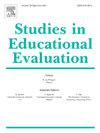How are pre-service physical education teachers’ perceptions of educator-created (dis)empowering climates associated with their motivational processes and teaching intention?
IF 2.6
2区 教育学
Q1 EDUCATION & EDUCATIONAL RESEARCH
引用次数: 0
Abstract
Building upon the bright and dark pathways outlined in Self-Determination Theory and Duda and Appleton's (2016) hierarchical conceptualisation of motivational climate, the purpose of this research was to examine how perceived educator-created (dis-)empowering climates can be combined and related to need-based experiences, quality of motivation, and teaching intention in initial physical education (PE) teacher education. A convenience sample of 369 pre-service PE teachers (197 men and 171 women, Mage = 27.28, SDage = 6.71) participated in this cross-sectional research. The results from the structural equation modelling found a positive relationship from a perceived empowering climate to teaching intention via need satisfaction and autonomous (indirect effect: β = .053, 95 %CI = .015–.091, p-value = .022), as well as a negative association from a perceived disempowering climate to teaching intention via need frustration and amotivation (indirect effect: β = -.046, 95 %CI = -.091 to − .002, p-value = .047).The results from the latent profile analysis identified four profiles with varying levels of (dis-)empowering climates. The high empowering–low disempowering profile was the most adaptive in motivational outcomes and teaching intention whereas the moderate empowering–very high disempowering and low empowering–high disempowering profiles were the most maladaptive, with the former having more controlled motivation and the latter being more amotivated. The moderate empowering–moderate disempowering profile was less adaptive than the high empowering-low disempowering profile, and less maladaptive than the moderate empowering–very high disempowering and low empowering–high disempowering profiles. This study highlights that the teacher educator combines (dis-)empowering climates to varying degrees with different contributions to specific motivational outcomes and teaching intention among pre-service PE teachers.
职前体育教师对教育者营造的(不)赋权氛围的看法与他们的动机过程和教学意图有何关联?
基于自我决定理论(Self-Determination Theory)中概述的明暗途径以及杜达和阿普尔顿(Duda and Appleton)(2016 年)对激励氛围的分层概念化,本研究旨在探讨在初始体育教师教育中,教育者所感知的(不)赋权氛围如何与基于需求的体验、激励质量和教学意向相结合并相互关联。369 名职前体育教师(男 197 人,女 171 人,平均年龄 = 27.28 岁,平均年龄 = 6.71 岁)参与了这项横断面研究。结构方程模型的结果表明,从感知到的赋权氛围到教学意向之间通过需求满足和自主性存在正相关关系(间接效应:β = .053,95 %CI = .015-.091,p 值 = .潜在特征分析的结果确定了四种不同程度的(失)赋权氛围。高赋权-低失权剖面在动机结果和教学意向方面最具适应性,而中等赋权-极高失权和低赋权-高失权剖面则最具适应性,前者的动机更受控制,后者的动机更不积极。中度赋权-中度失权状况的适应性低于高度赋权-低度失权状况,适应不良程度低于中度赋权-高度失权状况和低度赋权-高度失权状况。本研究强调,教师教育者在不同程度上结合了(失能)赋权氛围,对职前体育教师的特定动机结果和教学意向产生了不同的影响。
本文章由计算机程序翻译,如有差异,请以英文原文为准。
求助全文
约1分钟内获得全文
求助全文
来源期刊

Studies in Educational Evaluation
Multiple-
CiteScore
6.90
自引率
6.50%
发文量
90
审稿时长
62 days
期刊介绍:
Studies in Educational Evaluation publishes original reports of evaluation studies. Four types of articles are published by the journal: (a) Empirical evaluation studies representing evaluation practice in educational systems around the world; (b) Theoretical reflections and empirical studies related to issues involved in the evaluation of educational programs, educational institutions, educational personnel and student assessment; (c) Articles summarizing the state-of-the-art concerning specific topics in evaluation in general or in a particular country or group of countries; (d) Book reviews and brief abstracts of evaluation studies.
 求助内容:
求助内容: 应助结果提醒方式:
应助结果提醒方式:


